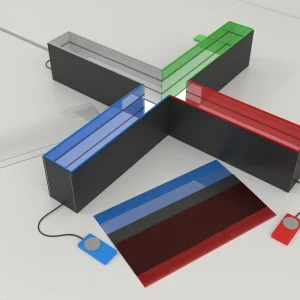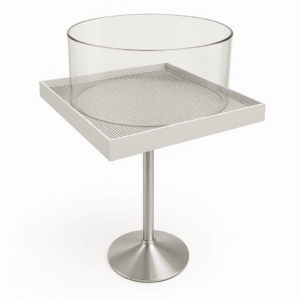$1,490.00
The Sound Attenuating Chamber is a specialized isolation unit designed to create a controlled environment by minimizing sound, electromagnetic interference, and light. This chamber is ideal for various conditioning experiments and can also be used to investigate the impact of audiogenic stress on rodent behavior and physiological responses.
The chamber is highly versatile and can be fitted with optional components such as levers, nose poke apertures, a speaker, a shock grid (if needed), and a food pellet dispenser for reinforcement. By blocking out external environmental noise, it ensures that laboratory distractions do not interfere with experimental results and removes the need for a separate operant conditioning chamber.
MazeEngineers provides the Sound Attenuating Chamber.

MazeEngineers offers custom-built behavioral mazes at no extra cost—designed to fit your exact research needs. Eliminate reproducibility issues from poor sizing or lingering scent cues with precision-engineered, modular, and smart mazes that adapt in real time to animal behavior. Publish new protocols, run adaptive experiments, and push the boundaries of behavioral science.



Optional:

Take advantage of Neuralynx, Ethovision Integration, SMS and Email integration with the Conductor Science Software. No I/O Boxes Required

The Sound Attenuating Chamber is a highly specialized isolation unit designed to maintain a controlled environment by minimizing sound, electromagnetic interference, and light. It is ideal for a variety of conditioning experiments and is particularly useful for studying the effects of audiogenic stress on rodent behavior and physiological functions.
This chamber features a range of adjustable components for enhanced versatility. It includes multi-layer soundproof insulation and offers optional upgrades such as manual or programmable LED lights, ambient and IR lights, an automated IR light system, a circulation fan, a camera mount, a syringe pump, an infusion pump, and a pull-out floor shelf for convenient waste removal. The chamber can be outfitted with two levers, two nose poke apertures, and two cue lights for conditioning tasks. These cue lights, positioned above the levers or apertures, can emit white, red, green, or blue light. An infrared sensor integrated with the nose poke apertures allows for automatic detection of responses. Additionally, a 20 mg pellet dispenser is available to provide rewards based on the subject’s performance criteria.
For further experimental flexibility, the chamber can be equipped with a shocker or frequency tone generator if required. By incorporating these features, the Sound Attenuating Chamber eliminates the need for separate operant conditioning chambers within a soundproof environment.
The chamber’s design effectively reduces external noise that might otherwise interfere with experimental outcomes. It also enhances auditory stimulus quality by minimizing sound reflections that could cause distortions, making it an essential tool for conducting multiple auditory discrimination experiments in close proximity.
The Sound Attenuating Chamber is a state-of-the-art isolation unit designed with advanced soundproofing, featuring multi-layer insulation to block external noise. It comes equipped with both visible and infrared light sources, a camera mount, and a pellet dispenser with a standard capacity of 20 mg, with an option to upgrade to a 45 mg dispenser upon request.
This chamber can be customized with two levers, two nose poke apertures, and two cue lights. The nose poke apertures are positioned 1 cm above the floor on an interactive panel and measure 1.3 x 1.2 x 1.2 cm (width × height × depth). The panel also includes the two stainless steel levers, available in widths of 1.6 cm for rats or 1 cm for mice.
Additionally, the chamber features a syringe pump with a 12 mm internal diameter and an adjustable RPM range from 0.5 to 60. An infusion pump is also included.
For more complex conditioning protocols, the chamber can be fitted with a removable shocker grid. This grid delivers shocks ranging from 0.1 to 4.0 mA in 0.1 mA increments and can be controlled either manually or via software.
Fill the pellet dispenser before starting the experiment. Remove the tray beneath the chamber and remove any waste material between test sessions.
The following is a sample conditioning protocol to analyze resurgence behaviors using the sound-attenuating chamber.
Position the subject inside the sound-attenuating chamber and activate the cue light associated with one of the levers. When the subject presses the illuminated lever, provide a food pellet as a reward. Subsequently, implement a 15-second variable interval reinforcement schedule, delivering a food pellet each time the subject presses the designated lever. If the subject engages with the non-target lever, do not provide any food reward or other consequences. Complete twenty baseline sessions to establish initial behavior patterns. Following these sessions, divide the subjects into three groups of six, ensuring that the frequency of lever pressing on the target lever during the final three sessions is consistent across all groups.
Position the subject inside the chamber and activate the stimulus light on the designated lever, as well as the light for one of the nose-poke apertures. Unlike in phase 1, do not provide a reward for pressing the target lever. Instead, deliver a food pellet and an additional form of reinforcement whenever the subject inserts its nose into the illuminated aperture, following a 15-second variable interval reinforcement schedule. Complete fifteen sessions with this setup.
Implement distinct treatments for each group during the resurgence test. For the control group, continue delivering food pellets as in Phase 2, maintaining the same reinforcement contingencies. For the Resurgence-Control group, completely halt the delivery of food pellets and any associated food-related stimuli. For the Stimulus group, detach the tubing that connects the pellet dispenser to the food aperture, so that nose pokes only trigger an audible click from the dispenser without dispensing any food. Run five sessions for each group under these conditions.
Craig, Browning, and Shahan (2017) investigated whether delivering reinforcer-associated stimuli during resurgence testing mitigated resurgence. The experiment was conducted using an operant chamber housed in a sound-attenuating chamber. The operant chamber was equipped with levers, nose poke apertures, cue lights, and a pellet dispenser. Eighteen, ninety-day-old male Long-Evans rats were divided into three groups of six and used in the experiment. The experiment was divided into three phases: baseline testing, treatment, and resurgence testing. The food pellets were delivered after pressing the lever in phase 1 and after nose pokes in phase 2, each after a variable 15-second interval schedule of reinforcement. During resurgence testing, trials were conducted in the same manner as phase 2 for the first group. For the second group, pellet dispensing and cue illumination were suspended. For the third group, only the food-correlated stimuli were produced without delivering the food reward. Results indicated that resurgence was lower in the group that received food-correlated stimuli than it was for the group that received no consequences for nose pokes. Moreover, target-lever pressing did not increase in the first group between the three phases. However, it resurged for the second and third groups.
Foote and Crystal (2007) investigated metacognition in Sprague-Dawley rats using an operant chamber housed in a sound-attenuating chamber. The experiment was divided into study, choice, and test phases. During the study phase, a sound was presented to the subjects to classify as short (2–3.62 s) or long (4.42–8 s). The choice phase comprised of presenting the subject with either one or two response options. During one response option, a single nose-poke aperture was illuminated that the subject had to select, which led to the duration test, and the subject was not allowed to decline the test. During both response options, both the nose-poke apertures were illuminated. If the subject poked its nose in one of the apertures (which indicated accepting the test response), it led to the insertion of two response levers, which led to the duration test. During the duration test, the subject had to discriminate between short and long noise durations. The presentation of a short noise indicated one lever as the correct response, and a long noise indicated the other lever as the correct response. Nose pokes in the other aperture indicated a declining test response and no duration test was produced. During the test phase, six large pellets were given as a reward if the correct lever was pressed with respect to the duration of discrimination. On the other hand, an incorrect lever press produced no reward. Declining a response in the test phase produced a smaller reward of three pellets. Results indicated that when the discrimination of the noises increased, the rate of declining the test also increased. Moreover, the accuracy of selecting the correct lever also declined as the difficulty of discrimination increased.
The following parameters can be observed using the Sound Attenuating Chamber:
The Sound Attenuating Chamber provides a controlled sound environment for conducting conditioning experiments, removing the necessity for separate operant chambers. It features two levers and two nose poke apertures, offering flexibility for the experimenter to use one or both types of responses in their protocols. The chamber includes configurable cue lights positioned above the levers and apertures, allowing the experimenter to select various colors to enhance the subjects’ discrimination tasks. Additionally, it has a speaker capable of emitting sounds across a frequency range of 100-40,000 Hz. The chamber also contains a pellet dispenser for delivering food rewards and can be fitted with a shocker grid if required. With its diverse range of stimuli and reinforcement options, the Sound Attenuating Chamber supports a variety of conditioning protocols.
There are no questions yet. Be the first to ask a question about this product.
Monday – Friday
9 AM – 5 PM EST
DISCLAIMER: ConductScience and affiliate products are NOT designed for human consumption, testing, or clinical utilization. They are designed for pre-clinical utilization only. Customers purchasing apparatus for the purposes of scientific research or veterinary care affirm adherence to applicable regulatory bodies for the country in which their research or care is conducted.